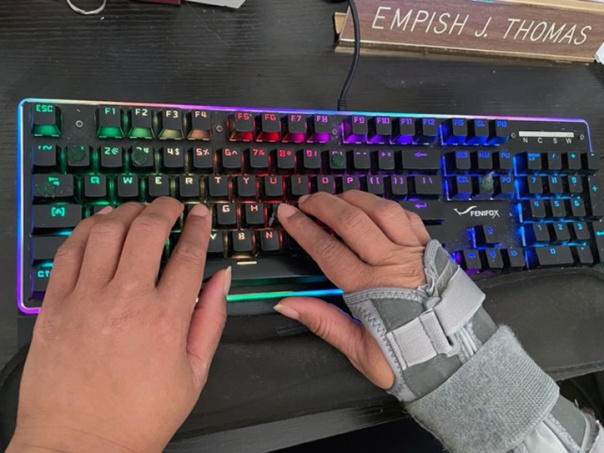
Last week I attended a writing discussion group for blind and low vision writers and authors. The Hadley Institute for the Blind and Print Impaired hosted this monthly meeting. We shared self-editing tips. When crafting an article, blog post, essay, poem or even a book, editing is critical. Self-editing even more so.
I want to present my very best work before I submit to and editor or hit that publish button on a blog post. I am a perfectionist and comb over a piece with nitpicking precision. To avoid this I have shortened my self-editing time with the tips below.
Talk to Me
1. reading my work out loud is one of the most important and frankly required self-editing hacks I use daily. My screen reader reads my post catching errors and awkward sentences. Listening to its rambling I hear pronunciations, pausing and inflections. Many years ago I upgraded to a screen reader with a more human-like voice; allowing me to really hear how my writing will sound when spoken by a real person.

Also, in my screen reader settings I have it programed to read all punctuation. So, It will notice places where there are commas, question marks, periods and etc. It will speak and /or pause at those places within a sentence.
If you are a sighted writer, many word processing software have built in screen readers. I know within Windows there is one called Narrator. I don’t use it often but it comes in handy when my screen reader is having a bad day and won’t talk to me.
Seek Repetition and You Will Find
2. I don’t always notice redundancies when writing. I am not paying attention because the words are flowing and I’m in the zone. It is when I go back and start editing I notice the number of times one particular word has been used over and over and over again. Get my drift? A great self-editing tip is to use the find feature on your word processing software. In Microsoft Word I use Control and the letter f to find those pesky repetitive words. I can stop at each one and use an alternative.
Active vs Passive
3. Are you active or passive? Using an active voice creates stronger and more powerful writing. Instead of using verbs like was, were, has been, to and be, find more commanding words to get your point across. Using active voice also cuts down on extra words and helps you to write tight. During the self-editing process, double check for active voice. You can even use the find feature for this tip too.
Long and Short Sentences

4. Is your piece long or short? Edit line by line and/or paragraph by paragraph. This ensures proper sentence structure, clarity and grammar usage. It also signals variations of long and short sentences. A combination of both helps with eye reading and creating enough white space on the page.
Review Hyperlinks
5. Double check hyperlinks. I am a blogger and use hyperlinks in my posts. I always go back and verify the link for the anchor word goes to the actual website. Many times I found the link didn’t work or went entirely some place else.
Edit One Step at a Time
6. When I start editing I break it down into chunks. First Irun a spell and grammar check. Next I go line by line or paragraph by paragraph. Then I search for repetitive words. I love WordHippo because it gives great synonyms for words I use too many times. You can make a little reminder cheat sheet to edit one step at a time.
Use Keyboard Bump Dots

7. I am a keyboard user and when I get going my typing can suffer. This causes more time and energy editing. I use self-adhesive bump dots on specific keys. You know those keys and symbols you barely use? Sticking a bump dot there avoids keypunch errors.
Spell Correctly Proper Names and Places
8. Don’t assume you spelled proper names correctly. Names of cities, states, street addresses, people, companies, etc. should all be checked for accuracy. I remember writing a business owner’s profile article for my local community paper. I spelled the owner’s first name wrong. I assumed since it was a common name I knew how to spell it. My editor caught it in time before publishing. But boy was it a valuable lesson learned. What an embarrassment it would have been for the person to read their story and their name spelled wrong. Yikes!
Sleep on It

9. After writing your masterpiece step away. Or even sleep on it. It is easy to miss mistakes after devoting lots of time and energy to your work . You are too close to the action. Depending on my writing deadline I will sleep on it and come back the next day refreshed and with new audio eyes. Your brain will recharge and read what you actually wrote, not what you think you did. When I step away and come back I see obvious errors I need to correct.
Use Correct Style Guide
10. The AP Style Book is my go-to resource for correct journalistic style writing. When I was in j-school it was call literally “the Journalist Bible” because of its educational and useful information. We all had our own dog-eared version writing copy for the campus newspaper. Now, I use the online version or do a Google search with the words “AP style” in the search box. However, for creative writing it is the Chicago Manual of Style. Regardless of the type of writing you are producing use the correct style manual.
Read One More Time
11. Before pressing that publish or send button read it again. Just one more time to be on the safe side. It won’t hurt, especially if you catch an error or two. You will be glad you did it.
Leave a comment